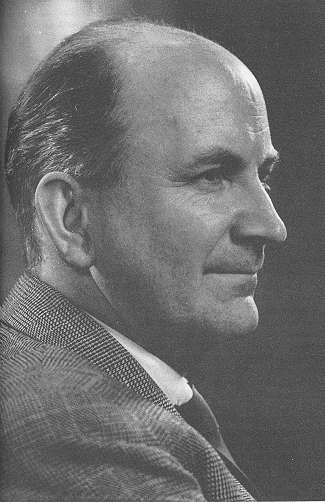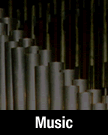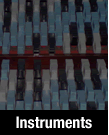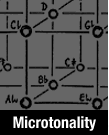Henk Badings
 Henk Badings was born on 17 January 1907 in Bandung (Java).
He studied mining technology at the University of
Technology in Delft, received his degree cum laude in 1931 and worked at the
university until 1937. In the meantime he developed his skills as a
composer. He was also active with painting, sculpting and writing poetry.
The only music lessons he followed were lessons in orchestration with
Willem Pijper. Already in the same year of his graduation, his First Cello
Concerto was performed in the Concertgebouw in Amsterdam, after which
performances of other works followed quickly.
Henk Badings was born on 17 January 1907 in Bandung (Java).
He studied mining technology at the University of
Technology in Delft, received his degree cum laude in 1931 and worked at the
university until 1937. In the meantime he developed his skills as a
composer. He was also active with painting, sculpting and writing poetry.
The only music lessons he followed were lessons in orchestration with
Willem Pijper. Already in the same year of his graduation, his First Cello
Concerto was performed in the Concertgebouw in Amsterdam, after which
performances of other works followed quickly.
In 1937 his violin sonata was played at the International Music Festival in
Prague. The next year this sonata and a string quartet were published with
Schott in Mainz. Badings gained public interest in a very short time.
In 1934 he was appointed as composition teacher at the Rotterdam Conservatory
and the High School of Music (muzieklyceum) of Amsterdam, of which he became
director in 1938. In 1937 he decided to dedicate himself to music definitively.
From 1941-1945 he was director of the Conservatory in The Hague and in 1949 he
became a member of honour of the Flanders Academy of Sciences. He was lecturer
of composition at the organ academy of Haarlem, lead orchestration courses for
conductors in Hilversum, and was from 1961 to 1972 professor at the
Musikhochschule in Stuttgart. In 1956 he received a commission from the
Holland Festival, which was the direct motive for Roelof Vermeulen to found the
electronic music studio of Philips in Eindhoven. Badings realised his ballet music
Kaïn and Abel there, and wrote many electronic compositions in that period of
time. The studio of Philips was meant to be temporary, still it remained open
until the end of 1960, and continued under the name STEM as part of the
University of Utrecht. After the departure of Vermeulen Badings became director
of STEM for a short period. This ended in June 1964 and STEM continued under the
guidance of Gottfried Michael Koenig and Frank de Vries. Badings would never
return there. As a guest conductor he went to Australia and the United States.
He received commissions to write orchestral works for the centenary celebration
of the Wiener Philharmoniker en de 60th anniversary of the Concertgebouw Orchestra,
an opera and Psalmensymfonie for the Holland Festival, an overture for the
Cork Festival in Ireland, etc. In 1972 he settled as composer in the province Noord-Brabant.
He died on 26 June 1987 in Maarheeze.
In his book 70 jaar Nederlandse Muziek 1915-1985, musicologist
Leo Samama counts Henk Badings to one of the five largest Dutch composers of the
twentieth century. Samama speaks in the chapter about Badings of his great
appreciation for this versatile composer: "The hundreds of compositions by
his hand testify of a versatile artist who switches seemingly effortless
from serious concert music to the style of the great American
'wind bands', from electronic music to educational bundles, from large
and dramatic choral works to work for amateur orchestras. His musical style,
lyrical and moody, heroic and exuberant, dramatic and effective, remains pervasive
and leaves its mark on every score. What Badings wrote between 1930 and 1960, is of
international allure. But also his later works are loved particularly in the
United States and show an unbridled energy and spiritual strength."
(Leo Samama, 1986).
Badings very often used unusual musical scales and harmonies.
Already in 1924 he consistently employed the octatonic scale (alternating
major and minor seconds); also he used the harmonic series scale from the
eighth to the fifteenth overtone. Music based on this scale gives the
impression that it is in just intonation, Badings himself called this mode
'lydo-mixolydian'.
In Henk Badings' extensive oeuvre of hundreds of works, the 31-tone music has
an important place. Without doubt it can be said that he has made the largest
and most important contribution to the Dutch 20th-century 31-tone music.
Around 1950 Badings became interested in new tone systems, six- and seven tone
modes and the acoustic backgrounds. In 1951 he wrote an interesting treatise
for the Royal Flemish Academy of Sciences titled Tonaliteitsproblemen in de
nieuwe muziek (tonality problems in new music).
After 1951 he wrote a number of compositions for the 31-tone organ in
Haarlem and in 1952 he created his first electronic compositions. For the
occasion of the 250th birthday of Leonhard Euler he was invited by the Swiss
Radio to write a series of 31-tone organ works. His works are characterised by
classical form, in melodic as well as rhythmic and harmonic aspect.
In 1978 he wrote another treatise for the Royal Flemish Academy of Sciences:
Over 31-toon-stemming. In het algemeen en in het bijzonder gedemonstreerd aan
de hand van een eigen compositie (about 31-note tuning: general principles
and a specific demonstration by means of a composition by the author).
Badings wrote Stringquartet 4 in commission of the Huygens-Fokker
Foundation. The first movement has the feeling of a slow introduction,
in which the musical material develops itself gradually. Especially notable
is the use of sum and difference tones; by for example adding two low tones to
a chord, higher tones emerge naturally. In this way very complex chords arise:
the opening chord has frequency ratios of 1:3:4:7:11:18.
The second part is a fast movement in a free sonata form. Because
intonating justly is more difficult in fast playing, Badings sought rescue in
the Euler genera, scales consisting of just thirds, fifths and/or sevenths.
The third part is like an elegy. The major and minor modes are mixed. In the
faster middle part, the main theme returns in the arioso melody of the cello.
The last movement is written in 11/4 time, in constantly differing
subdivisions.
Fragments of this string quartet on the music page.
For the famous Fokker organ Badings wrote four works, besides a composition
for the Archiphone. He wrote his Reeks
van kleine klankstukken in selectieve toonsystemen voor 31-toonsorgel
(Series of small sound pieces in selected tone systems for 31-tone organ) and
Suite van kleine klankstukken (Suite of small sound pieces) in 1954. In
the Reeks he makes use of a number of 12-tone scales which are
preprogrammed in the organ and can so be played on the traditional manual. It
is obvious he could not distance himself well from classical tonality; the
microtonality in this work is more ornamental, a colouring of classical tonality.
Music
The Sonata nr. 3 for two violins (1967) and Reeks van kleine klankstukken (1954)
are on the CD 50 jaar Stichting Huygens-Fokker.
Listen to more music of Badings on this website.
|










 Henk Badings was born on 17 January 1907 in Bandung (Java).
He studied mining technology at the University of
Technology in Delft, received his degree cum laude in 1931 and worked at the
university until 1937. In the meantime he developed his skills as a
composer. He was also active with painting, sculpting and writing poetry.
The only music lessons he followed were lessons in orchestration with
Willem Pijper. Already in the same year of his graduation, his First Cello
Concerto was performed in the Concertgebouw in Amsterdam, after which
performances of other works followed quickly.
Henk Badings was born on 17 January 1907 in Bandung (Java).
He studied mining technology at the University of
Technology in Delft, received his degree cum laude in 1931 and worked at the
university until 1937. In the meantime he developed his skills as a
composer. He was also active with painting, sculpting and writing poetry.
The only music lessons he followed were lessons in orchestration with
Willem Pijper. Already in the same year of his graduation, his First Cello
Concerto was performed in the Concertgebouw in Amsterdam, after which
performances of other works followed quickly.